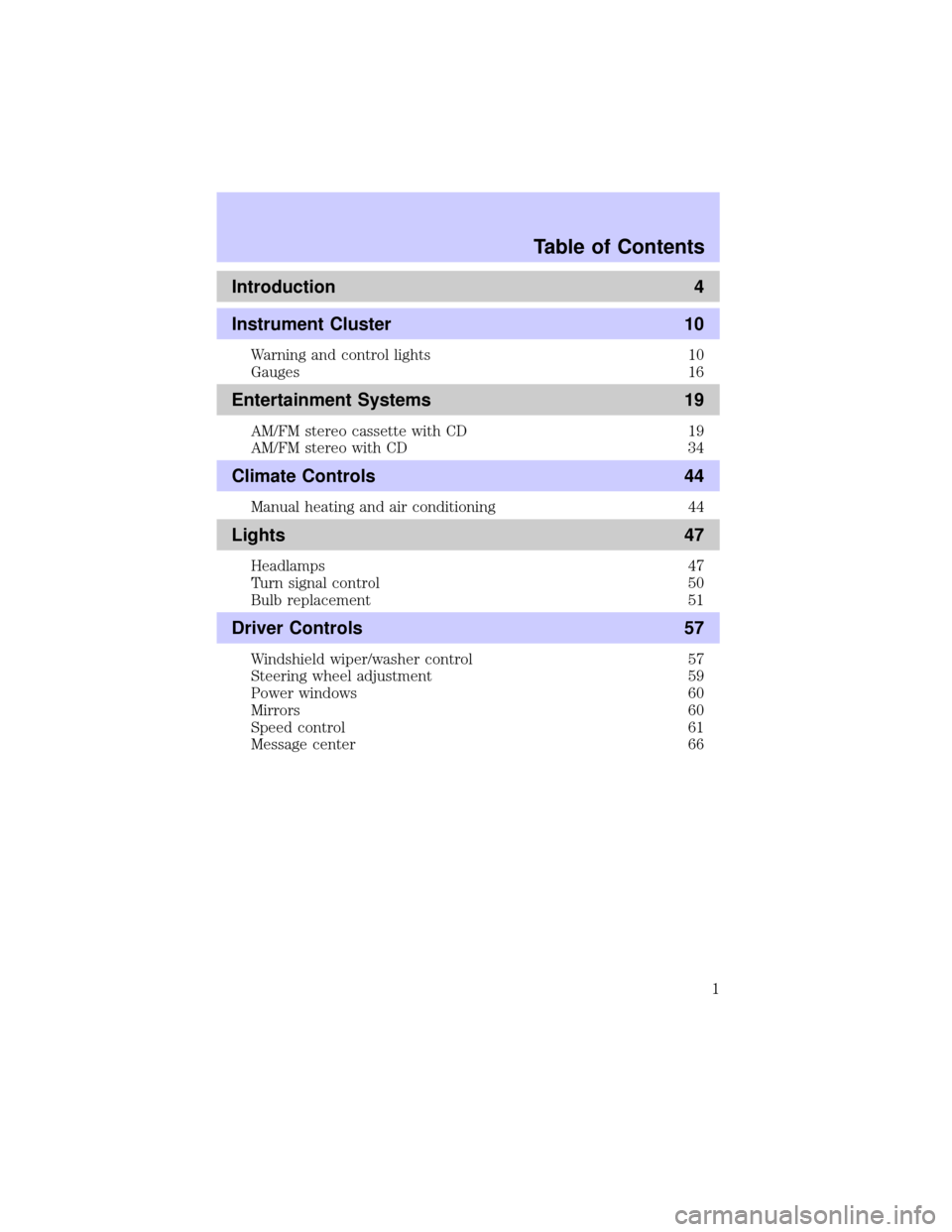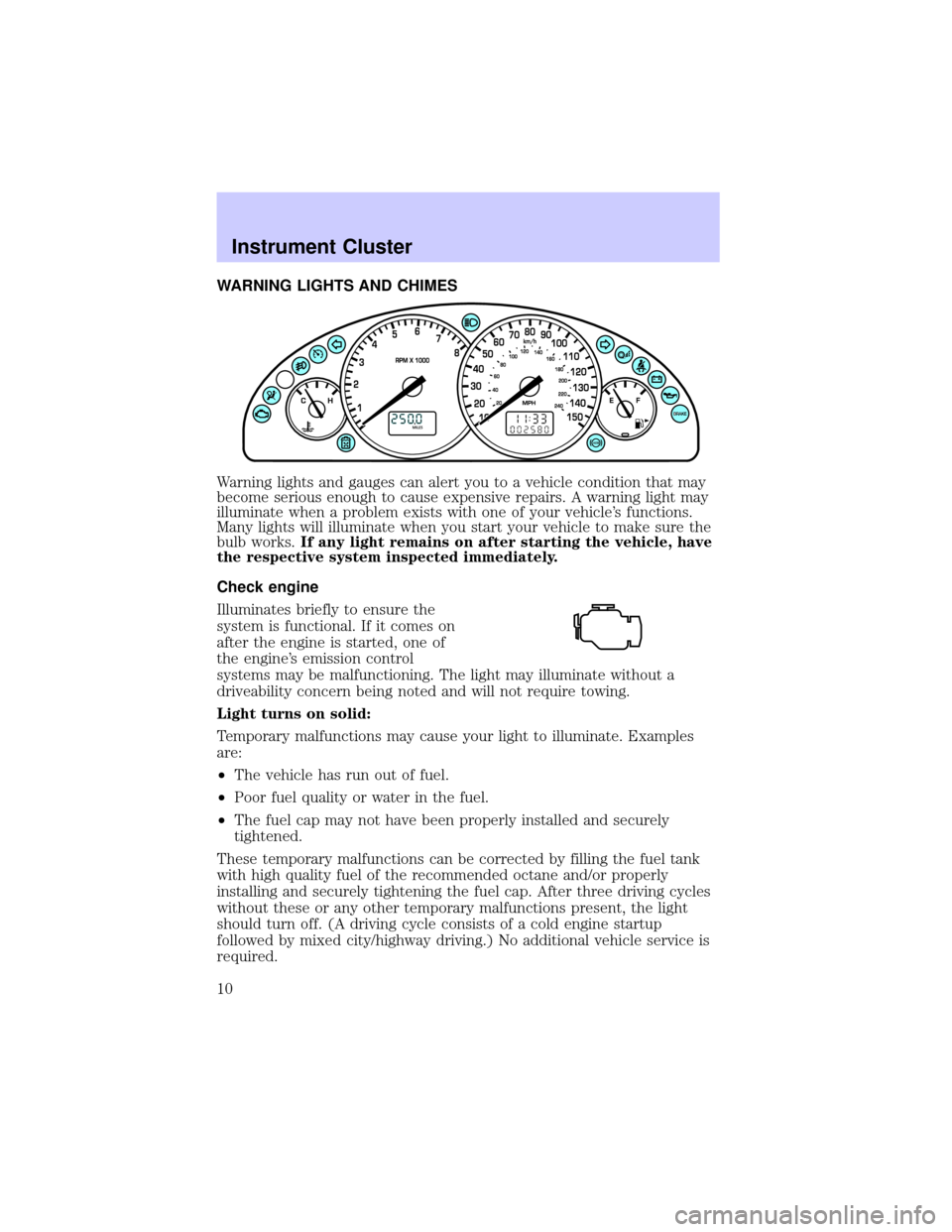warning lights Mercury Mercury Cougar 2002 Owner's Manual
[x] Cancel search | Manufacturer: MERCURY, Model Year: 2002, Model line: Mercury Cougar, Model: Mercury Mercury Cougar 2002Pages: 216, PDF Size: 4.04 MB
Page 1 of 216

Introduction 4
Instrument Cluster 10
Warning and control lights 10
Gauges 16
Entertainment Systems 19
AM/FM stereo cassette with CD 19
AM/FM stereo with CD 34
Climate Controls 44
Manual heating and air conditioning 44
Lights 47
Headlamps 47
Turn signal control 50
Bulb replacement 51
Driver Controls 57
Windshield wiper/washer control 57
Steering wheel adjustment 59
Power windows 60
Mirrors 60
Speed control 61
Message center 66
Table of Contents
1
Page 10 of 216

WARNING LIGHTS AND CHIMES
Warning lights and gauges can alert you to a vehicle condition that may
become serious enough to cause expensive repairs. A warning light may
illuminate when a problem exists with one of your vehicle's functions.
Many lights will illuminate when you start your vehicle to make sure the
bulb works.If any light remains on after starting the vehicle, have
the respective system inspected immediately.
Check engine
Illuminates briefly to ensure the
system is functional. If it comes on
after the engine is started, one of
the engine's emission control
systems may be malfunctioning. The light may illuminate without a
driveability concern being noted and will not require towing.
Light turns on solid:
Temporary malfunctions may cause your light to illuminate. Examples
are:
²The vehicle has run out of fuel.
²Poor fuel quality or water in the fuel.
²The fuel cap may not have been properly installed and securely
tightened.
These temporary malfunctions can be corrected by filling the fuel tank
with high quality fuel of the recommended octane and/or properly
installing and securely tightening the fuel cap. After three driving cycles
without these or any other temporary malfunctions present, the light
should turn off. (A driving cycle consists of a cold engine startup
followed by mixed city/highway driving.) No additional vehicle service is
required.
Instrument Cluster
10
Page 14 of 216

High beams
Illuminates when the high beam
headlamps are turned on.
Foglamps
Illuminates when the foglamps are
turned on.
Refer toFoglamp controlin the
Lightschapter.
OVERHEAD WARNING LIGHTS (if equipped)
These lights illuminate briefly to ensure the systems are functional.
Service intervals
Illuminates to indicate that routine
service should be performed. Check
your maintenance schedule to
determine the routine service to be
completed.
To reset the light, hold the SELECT
and UNITS controls on the trip
computer for five seconds. The light
will be illuminated and then extinguish after approximately four seconds.
Frost warning
Illuminates when ambient air
temperatures are between 0É C (32É
F) and 4É C (39É F). Theyellow
light warns of possible ice on the
roads.
Instrument Cluster
14
Page 112 of 216

STARTING
Positions of the ignition
1. LOCK, locks the steering wheel,
gearshift lever (automatic transaxle
only) and allows key removal. On
vehicles with a manual transaxle
push the key in while turning to
lock.
2. ACCESSORY, allows the electrical
accessories such as the radio to
operate while the engine is not
running.
3. ON, all electrical circuits operational. Warning lights illuminated. Key
position when driving.
4. START, cranks the engine. Release the key as soon as the engine
starts.
Preparing to start your vehicle
Engine starting is controlled by the powertrain control system. This
system meets all Canadian Interference-Causing Equipment standard
requirements regulating the impulse electrical field strength of radio
noise.
When starting a fuel-injected engine, avoid pressing the accelerator
before or during starting. Only use the accelerator when you have
difficulty starting the engine. For more information on starting the
vehicle, refer toStarting the enginein this chapter.
Extended idling at high engine speeds can produce very high
temperatures in the engine and exhaust system, creating the risk
of fire or other damage.
Do not park, idle, or drive your vehicle in dry grass or other dry
ground cover. The emission system heats up the engine
compartment and exhaust system, which can start a fire.
Do not start your vehicle in a closed garage or in other enclosed
areas. Exhaust fumes can be toxic. Always open the garage door
before you start the engine. SeeGuarding against exhaust fumesin
this chapter for more instructions.
Driving
112
Page 190 of 216

permitted to intentionally remove an emission control device or prevent
it from working. Information about your vehicle's emission system is on
the Vehicle Emission Control Information Decal located on or near the
engine. This decal identifies engine displacement and gives some tune up
specifications.
Please consult yourWarranty Guidefor complete emission warranty
information.
Readiness for Inspection/Maintenance (I/M) testing
In some localities, it may be a legal requirement to pass an I/M test of
the on-board diagnostics system. If your ªCheck Engine/Service Engine
Soonº light is on, refer to the description in theWarning lights and
chimessection of theInstrument clusterchapter. Your vehicle may not
pass the I/M test with the ªCheck Engine/Service Engine Soonº light on.
If the vehicle's powertrain system or its battery has just been serviced,
the on-board diagnostics system is reset to a ªnot ready for I/M testº
condition. To ready the on-board diagnostics system for I/M testing, a
minimum of 30 minutes of city and highway driving is necessary as
described below:
²First, at least 10 minutes of driving on an expressway or highway.
²Next, at least 20 minutes driving in stop-and-go, city-type traffic with
at least four idle periods.
Allow the vehicle to sit for at least eight hours without starting the
engine. Then, start the engine and complete the above driving cycle. The
engine must warm up to its normal operating temperature. Once started,
do not turn off the engine until the above driving cycle is complete.
CHECKING AND ADDING POWER STEERING FLUID
Check the power steering fluid.
Refer to the scheduled maintenance
guide for the service interval
schedules. If adding fluid is
necessary, use only MERCONtAT F.
1. Start the engine and let it run until it reaches normal operating
temperature (the engine coolant temperature gauge indicator will be
near the center of the normal area between H and C).
Maintenance and Specifications
190
Page 209 of 216

dipstick ....................................172
filter, specifications ........174, 198
recommendations ...................174
refill capacities ........................199
specifications ..................200±201
Exhaust fumes ..........................116
F
Floor mats ...................................68
Fluid capacities .........................199
Foglamps .....................................47
Fuel ............................................182
calculating fuel economy .......186
cap ...........................................183
capacity ...................................199
choosing the right fuel ...........184
comparisons with EPA fuel
economy estimates .................188
detergent in fuel .....................185
filling your vehicle with
fuel ...........................182±183, 186
filter, specifications ................198
fuel pump shut-off switch .....135
gauge .........................................17
improving fuel economy ........186
low fuel warning light ..............13
octane rating ...................185, 201
quality ......................................185
safety information relating to
automotive fuels .....................182
Fuses ..................................136±137
G
Gas cap (see Fuel cap) ............183
Gas mileage (see Fuel
economy) ...................................186
Gauges .........................................16engine coolant temperature
gauge .........................................16
fuel gauge ..................................17
odometer ...................................17
speedometer .............................17
tachometer ................................18
trip odometer ............................18
GAWR (Gross Axle Weight
Rating) .......................................129
definition .................................129
driving with a heavy load ......129
location ....................................129
GVWR (Gross Vehicle Weight
Rating) .......................................129
calculating ...............................129
definition .................................129
driving with a heavy load ......129
location ....................................129
H
Hazard flashers .........................135
Headlamps ...................................47
aiming ........................................49
bulb specifications ....................51
daytime running lights .............47
flash to pass ..............................48
high beam ...........................14, 48
turning on and off ....................47
warning chime ..........................15
Heating
heating and air conditioning
system .......................................44
Hood ..........................................168
I
Ignition ...............................112, 201
Infant seats
(see Safety seats) .....................106
Index
209
Page 210 of 216

Inspection/maintenance (I/M)
testing ........................................190
Instrument panel
cleaning ...................................164
cluster ........................................10
lighting up panel and
interior .......................................48
J
Jack ............................................142
positioning ...............................142
storage .....................................142
Jump-starting your vehicle ......145
K
Keys .......................................74±76
key in ignition chime ...............16
positions of the ignition .........112
L
Lamps
bulb replacement
specifications chart ..................51
cargo lamps ...............................48
daytime running light ...............47
fog lamps ...................................47
headlamps .................................47
headlamps, flash to pass ..........48
instrument panel, dimming .....48
interior lamps ...........................50
replacing bulbs .........................51
Lane change indicator
(see Turn signal) ........................50
Lights, warning and indicator ....10
air bag ........................................12
anti-lock brakes (ABS) ....11, 117
brake ..........................................11
charging system ........................12check coolant ............................12
check engine .............................10
cruise indicator .........................13
door ajar ....................................15
high beam .................................14
low fuel ......................................13
low washer fluid .......................15
oil pressure ...............................12
overdrive off ..............................13
safety belt .................................12
speed control ............................65
traction control active ..............13
turn signal indicator .................13
Load limits .................................129
GAWR ......................................129
GVWR ......................................129
trailer towing ..........................129
Locks
doors ..........................................70
Lubricant specifications ...200±201
M
Manual transaxle
fluid capacities ........................199
lubricant specifications ..........201
reverse .....................................127
Manual transmission .................125
Message center ...........................66
Mirrors
side view mirrors (power) .......60
Moon roof ....................................65
Motorcraft parts ........................198
O
Octane rating ............................185
Odometer .....................................17
Oil (see Engine oil) ..................172
Index
210
Page 212 of 216

rotating ....................................196
snow tires and chains ............198
tire grades ...............................196
treadwear ................................195
Towing .......................................130
recreational towing .................133
trailer towing ..........................130
wrecker ....................................151
Traction control ........................119
active light ................................13
Transaxle
fluid, refill capacities ..............199
lubricant specifications ..........201
Transmission
automatic operation ...............120
fluid, checking and adding
(automatic) .............................192
lubricant specifications ..........200
manual operation ....................125
Trip odometer .............................18
Trunk ...........................................70
remote release ....................67, 73
Turn signal ............................13, 50V
Vehicle Communication
System ...................................14±15
Vehicle dimensions ...................201
Vehicle Identification Number
(VIN) ..........................................203
Vehicle loading ..........................129
Ventilating your vehicle ...........116
W
Warning chimes .....................15±16
Warning lights
(see Lights) ...........................10, 14
Water, Driving through .............128
Windows
power .........................................60
rear wiper/washer .....................57
Windshield washer fluid and
wipers
checking and cleaning ..............58
operation ...................................57
replacing wiper blades .............58
Wrecker towing .........................151
Index
212